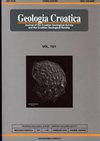Genesis of ferromanganese deposits from the Central Anatolian province, Yozgat-Aşağı Eğerci village, Turkey: Geochemical properties and fluid inclusions
IF 1.1
4区 地球科学
Q3 GEOLOGY
引用次数: 0
Abstract
Eğerci village is located 16 km southwest of Yerköy (Yozgat) area which has a ferromanganese deposit that formed at the contact between basalt and limestone and shows that a banded stockwork structure occurs occasionally within the limestone. The mineralization consists of pyrolusite, goethite, and ramsdellite, together with a lesser quantity of magnetite. Gangue minerals are determined as calcite and quartz. REE data from the mineral samples demonstrate a range from 2.70 - 63.70 ppm and the average value is 28.00. These results permit a comparison to be made with mineralization in hydrothermal deposits. Moreover, mineral samples show a positive Eu anomaly 0.88-48.10 ppm (ave. 9.94 ppm). The Ce anomaly values vary between 0.02 and 0.88 ppm (ave. 0.58 ppm). It is possible that the mineralization may be affected by the mixing of seawater and hydrothermal fluids. The value of the positive Eu anomaly is evidence of modern oceanic hydrothermal manganese deposits. Insight of previous fluid inclusion, studies can be easily inferred that mineralization can occur at three different stages. The temperature of the first stage ranged from 338 oC to 428 oC and other stages vary from 269 oC - 317 oC and 143 oC - 236 oC, respectively. As a comparison, calculated salinity is higher in Type I fluid inclusions (1.9-14.7 wt.% NaCl equiv.) than Type II and III fluid inclusions (1.9-5.1 wt.%NaCl (equiv.) It is possible that the mineralization was formed by the mixing of magmatic and meteoric waters.土耳其Yozgat-AşAğıEğerci村中安纳托利亚省铁锰矿床的成因:地球化学性质和流体包裹体
Eğerci村位于Yerköy(Yozgat)地区西南16公里处,该地区有一个在玄武岩和石灰岩接触处形成的铁锰矿床,表明石灰岩中偶尔会出现带状网状结构。矿化由软锰矿、针铁矿和ramsdellite以及少量磁铁矿组成。脉石矿物被确定为方解石和石英。矿物样品的REE数据显示其范围为2.70-63.70 ppm,平均值为28.00。这些结果可以与热液矿床中的矿化进行比较。此外,矿物样品显示正Eu异常0.88-48.10 ppm(平均9.94 ppm)。Ce异常值在0.02和0.88ppm之间变化(平均0.58ppm)。矿化可能受到海水和热液混合的影响。Eu正异常值是现代海洋热液锰矿床的证据。通过对以往流体包裹体的深入研究,可以很容易地推断出矿化可以发生在三个不同的阶段。第一阶段的温度范围为338℃至428℃,其他阶段的温度分别为269℃至317℃和143℃至236℃。相比之下,I型流体包裹体(1.9-14.7wt.%NaCl当量)的计算盐度高于II型和III型流体包裹物(1.9-5.1wt.%NaCl(当量))。矿化可能是由岩浆水和大气降水混合形成的。
本文章由计算机程序翻译,如有差异,请以英文原文为准。
求助全文
约1分钟内获得全文
求助全文
来源期刊

Geologia Croatica
GEOSCIENCES, MULTIDISCIPLINARY-
CiteScore
2.90
自引率
23.10%
发文量
35
审稿时长
>12 weeks
期刊介绍:
Geologia Croatica welcomes original scientific papers dealing with diverse aspects of geology and geological engineering, the history of the Earth, and the physical changes that the Earth has undergone or it is undergoing. The Journal covers a wide spectrum of geology disciplines (palaeontology, stratigraphy, mineralogy, sedimentology, petrology, geochemistry, structural geology, karstology, hydrogeology and engineering geology) including pedogenesis, petroleum geology and environmental geology.
Papers especially concerning the Pannonian Basin, Dinarides, the Adriatic/Mediterranean region, as well as notes and reviews interesting to a wider audience (e.g. review papers, book reviews, and notes) are welcome.
 求助内容:
求助内容: 应助结果提醒方式:
应助结果提醒方式:


